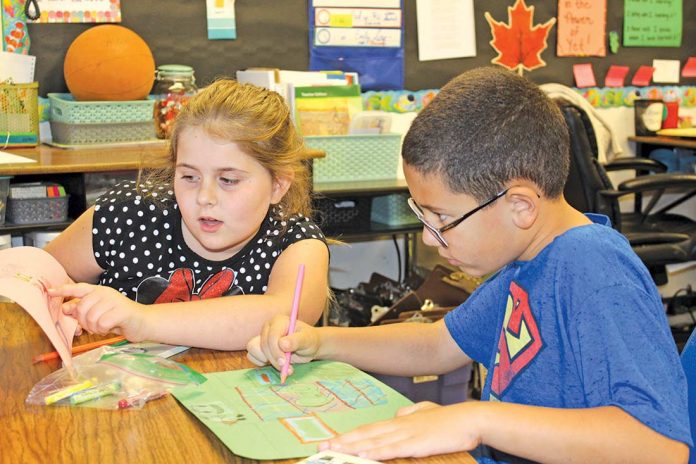
It’s the Friday before Thanksgiving break, and Katherine Alosi’s third grade class is working diligently on their latest assignment. In any other classroom, this may be a rarity—especially an hour from dismissal—but this Gabilan Hills Elementary School class has proven to be an exception when it comes to their art lessons.
Today, their teaching artist from San Benito County Arts Council, Clay Peer, has shown them how to sketch and color a cake, using skills learned in previous lessons.
“It’s exciting,” beamed third-grader Chantal Saucedo. “The first day we met [Clay], he taught us how to draw Legos. He also had something cut out for us, like a leaf, then we traced it. We used color pastels, and used cold colors and warm colors to color it after.”
It’s this kind of excitement about art—and the desire to learn its techniques—that Superintendent Diego Ochoa was hoping for when he helped launch the expansion of Hollister School District’s partnership with San Benito County Arts Council over the summer.
“It was the partnership that the Arts Council had with the County Office of Education that led me to want to pursue more arts education,” Ochoa said. “In my work with Superintendent Krystal Lomanto, she just really explained to me how integral the Arts Council has been in developing these programs. That’s a big part of where this program came from; my collaboration with Krystal.”
Since September, every third through fifth grade classroom throughout the district has been part of the art education program provided by the SBC Arts Council. Teaching artists visit school sites throughout the week to ensure each class receives one art lesson per week.
While the SBC Arts Council’s pre-existing partnership with HSD schools (with one or two programs per year) established a spark for students, it was only “a drop in the bucket,” admitted Jennifer Laine, executive director of the SBC Arts Council.
But when Amanda Chiado, director of the Arts Education for the SBC Arts Council, began collaborating with Ochoa over the summer, both—fairly new to their positions—were able to bring fresh perspectives and knowledge to their partnership, leading to the new expansive program.
“This program is new and is definitely aimed at having a deeper and longer lasting impact,” Laine said.
In preparation for the program, nine new teaching artists were hired onto the SBC Arts Council to teach the curriculum. Each are now working an average of 20 hours a week at the schools. Chiado is excited about this development, since the artists are now being brought into the schools “for something that’s really consistent.”
Peer, for instance, teaches art to 16 classes—or roughly 400 students.
“I’m on [the Gabilan Hills] campus five days a week,” he said. “Monday, Wednesday and Friday is with the Hollister Dual Language Academy; I see third, fourth and fifth there. And then Thursday and Friday is with Gabilan Hills.”
Homeroom teachers are also benefiting from collaborative opportunities with the teaching artists—developing their own skills and honing in on those of their students.
“It’s helping my students with their fine motor skills,” Alosi said. “And it’s making them more confident and more ready to use the mediums. When Clay is not here, I do art with them and it really does make a difference. They’re more confident when we do our projects together.”
By being taught the California Visual and Performing Arts standards (required for California elementary school students—but not often met), students are also getting a foundation that are preparing them for future art classes.
“It is great for our kids to be accessing what it looks like nationwide to have a real robust arts education program,” Chiado said. “They are working with line, shape, color and design elements. And then they can build on those skills as they move into more complex projects such as working in 3-D or working with clay. They’re also able to use sketchbooks for transitions and to practice all of the skills that they’re learning.”
It was a purposeful decision to have multiple grade levels throughout the district be exposed to this year’s program, according to Ochoa.
“We know that the sixth-graders in 2022 are going to have had three full years of arts instruction that they’ve been receiving, going back to when they were in third grade,” he said. “So I’m feeling appreciative for what we’re doing now, but I’m feeling really hopeful about what we’ll do in the future.”
He is also expecting unprecedented benefits of the program to come to surface.
One already has: an improvement in attendance since the program kicked off.
“We’d like to think that this program has played a part in that,” Ochoa added.
According to Peer, it’s played a huge role.
“I had some kids tell me they’re coming to school because of it,” Peer said.
Another potential gain Ochoa believes will be seen is an improvement in students’ social and emotional health.
“I think we’re going to see, as the program continues to develop, that it gives kids an artistic avenue to express how they’re feeling,” he said.
Chiado explained that data from all these variables are being collected so that the strengths and weaknesses of the program can be studied for future lessons.
“We’re in constant communication with teaching artists and classroom teachers to make modifications on the spot or to really adapt a program to fit the needs,” she said. “Especially for our special day class students. We really look at equity deeply.”
As for Ochoa, he plans on expanding the arts program in the future for the Hollister School District.
“As an educator, arts education really exemplifies the highest level of critical thinking, decision-making, rationalizing and editing,” he said. “So I’m feeling appreciative for what we’re doing now, but I’m feeling really hopeful about what we’ll do in the future.”
The San Benito County Arts Council office is located at 240 Fifth St. in Hollister. For information on its programs, call 831.636.2787 or email in**@***********ts.org.









